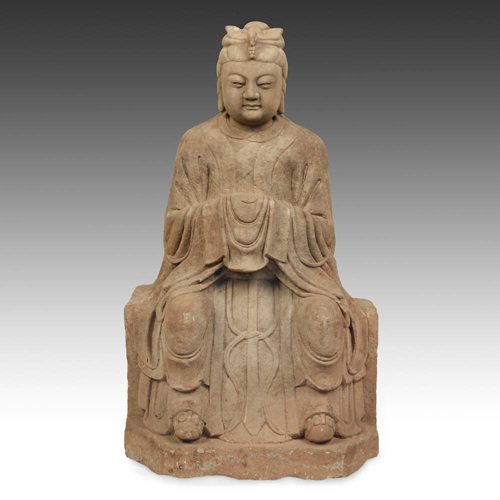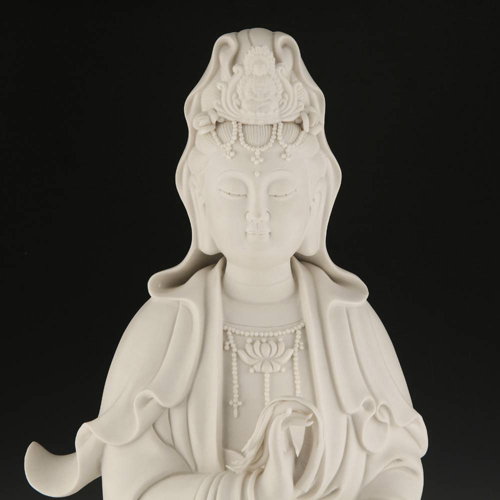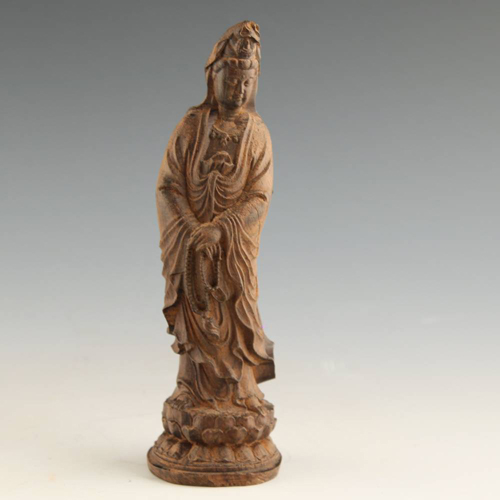 |
|
|
|
By格伦joffe.
It’s impossible to deal in world art on any scale and not have frequent encounters with world religion. There are simply too many intersections; perhaps because there aren’t five religions in the world, but at last count somewhere around forty-two hundred. Each of them has their own customs, rituals, history, practitioners, and of course, deities, whether they be one or many. The pursuit of spiritual beliefs appears to be a common denominator among humankind. These beliefs bind us together across geography and time, and they are frequently expressed through the creation of artwork. In turn, perhaps the most common subject one encounters in religious art is the depiction of deities - saints, gods, bodhisattvas, demons and demi-gods. They populate – even dominate - religious art, appearing in just about every medium imaginable. All this art begs the question: what do these deities really represent?
 |
|
|
|
One of the most frequently depicted deities found anywhere in the world is Quan Yin. To fully understand Quan Yin, it is necessary to begin with a discussion of Avolokitesvara, the Buddhist Bodhisattva (which can be defined as a Buddha-to-be) of infinite compassion and mercy. Beloved throughout all schools of Buddhism, Avolokitesvara personifies perseverance and patience, for this deity is said to have postponed their own Buddhahood so every sentient being on earth could be liberated from suffering. Avolokitesvara is the embodiment of compassion, and by extension, mercy, which flows from compassion. Creation myths abound for Avolokitesvara. In one story, he (remember the “he” part) was born from Buddha’s tears. In another, he was born from a ray of light emanating from the eye of Amitabha, the Buddha of Infinite Light. In either event, there are different creation myths for Avolokitesvara, who is first mentioned in the Buddhist Sutras, specifically the Lotus Sutra. In essence, the Sutras represent the canonical texts of Buddhism, and the Lotus Sutra is said to contain the final teachings of Buddha with instructions for salvation. It is fair to say that Avolokitesvara has been around for almost as long as Buddha himself.
 |
|
|
|
从历史上思考,它是不可避免的,即Avolokitesvara的崇拜将符合佛教本身的传播。换句话说,随着佛教传播所以崇拜Avolokitsvara。然而,神的名称在世界不同的国家和地区发生了变化。在西藏,对于Avolokitesvara的崇拜而不是完全归零,他被称为Chenrezig。达赖喇嘛据说是Avolokitesvara的转世。在柬埔寨和泰国,Avolokitesvara被称为Lokesvara。这可能是因为在梵语“埃斯瓦拉”意味着勋爵和“洛卡”意味着世界,全名Avolokitesvara翻译为“凝视世界上的主人”。当Avolokitesvara的崇拜到达中国时,神灵被称为Quan Yin或观音。中国名字观音对于冠尾林来说是短暂的,这是翻译为“感知世界声音的人”。学术思考建议Avolokitesvara被错误地翻译成“凝视声音”而不是世界的“他凝视着声音”。 The Chinese scholar Xuanzang (602-664 A.D.) was a Buddhist monk who translated the name Avolokitesvara as Guanzizai, which provides this translation. Yet, none of this matters. By the time the worship of Avolokitesvara reached China, the literal translation of Avolokitesvara as Guanyin or “sound perceiver who hears the cries of sentient beings” became the accepted name – and Quan Yin an accepted form of Guanyin.
 |
|
|
|
神灵需要时间来扎根,并在生活的眼中进化;特别长时间捕捉人们的流行想象力并超越宗教。这是中国在中国发生的事情发生了什么。她从佛教神中发展到一个捕捉佛教徒和非佛教徒的想象力的流行图标。有报道称,早在第一世纪的广告中,Quan Yin的崇拜是Avolokitesvara的崇拜。到了7世纪,这个名字改变了。所有人都是艺术家的一个受欢迎的主题。早期插图描绘了Quan Yin作为男性。四世纪周围的泉吟被描绘为女性。The Lotus Sutra states Avolokitesvara can take the form of male or female, so it wasn’t a big leap for artists to begin representing Quan Yin as a goddess in beautiful flowing robes, adorned with jewels to signify the majesty of her teachings, and with a serene, compassionate countenance. Those types of depictions stuck, and today Quan Yin is mostly illustrated as female.
 |
|
|
|
反过来,作为她与母性,生育和保护儿童有关的女性。如果她可以保护孩子,那么她也可以保护任何风险;例如,病人和残疾人。在一个传说中,Quan Yin住在一个她冥想并帮助搁浅的渔民的岛屿上,所以她扩大了她的职责,成为海员的保护者。她作为女神扩展的范围。她不再是纯粹的佛教神,她在中国民间宗教中崇拜,并作为道教中的一个不朽之一。她成为商人的启蒙和崇敬的象征,因为它被认为她可以赐予好运。谁不想要一剂好运?简而言之,泉尹成了一个在周围deity capable of protecting, saving, healing, and wish-fulfilling, and all the while she remained a central character in art as a means to make people’s beliefs tangible and celebrate the power of those beliefs.
 |
|
|
|
In the roughly 2,500 years since the birth of Buddhism, Quan Yin has grown beyond her Buddhist roots. Today, she is venerated, worshipped and invoked for many, many reasons. Of course, it is still believed she is the source for infinite compassion and mercy, but she is also the first deity to whom people turn in times of trouble or want and the first to whom they give gratitude for blessings. Artistic depictions of Quan Yin can be like lightning rods where human desire and the power of belief coalesce to produce positive outcomes. All living things have a life cycle. At the same time, beliefs and the meaning of symbols can change. In the case of Quan Yin, new beliefs were added while old beliefs remained relevant; and over time she became a more diversified symbol for a greater audience. In the life cycle of deities, she is alive and well, still serving as a bridge between the real and imagined worlds - the worlds of humankind and divinity.




